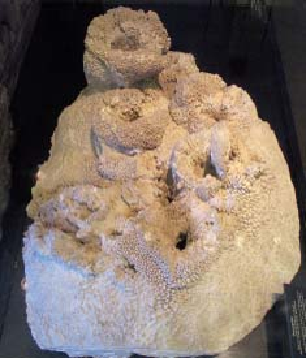Travel Reference
In-Depth Information
Geyserite cone donated by Supt. Norris to the Smithsonian
(Foley, 2006)
East toward Echinus
Near the trail junction on the left are small
Corporal Geyser
and tiny
Dog Leg Spring
with
two small vents. When one of these geysers erupts the other drains.
On the right is
Veteran Geyser,
which probably derived its name from the very old sinter
deposits all around. Veteran's short eruptions may go out 40 feet (12 m) at an angle, but they
occur in a long-term cyclic pattern of minutes to hours that is not yet fully deciphered.
At the boardwalk intersection is
Cistern Spring.
The remarkable colors in the runoff are
unusual for Norris Basin—unless you are here during a seasonal disturbance when you may
see only murky water. Cistern built its impressive terrace in the past few decades. Bacteria col-
or the terraces canary yellow, orange, and brown when the pool is full. True to its name as a
water reservoir, Cistern's water drains drastically when neighboring Steamboat Geyser has a
major eruption; without the water, the bacteria die.
North toward the museum
If you turn back from Cistern and take up the loop trail again, or if you have continued
straight on at the trail junction after crossing Tantalus Creek, you'll first encounter
Palpitator
Spring.
Palpitator is actually a geyser and has small but extremely long eruptions of around
three hours. It was named for steam pulsing below the ground that once produced uncannily
rhythmic beats.

